Rear Suspension Support Crossmember Replacement All Wheel Drive
Removal Procedure
- Disconnect the negative battery cable. Refer to Battery Negative Cable Disconnection and Connection.
- Raise and support the vehicle. Refer to Lifting and Jacking the Vehicle.
- Remove the 2 rear tire and wheel assemblies. Refer to Tire and Wheel Removal and Installation.
- Remove the exhaust muffler. Refer to Exhaust Muffler Replacement.
- Remove the catalytic converter. Refer to Catalytic Converter Replacement.
- Remove the propeller shaft. Refer to Propeller Shaft Replacement.
- Remove the rear axle shaft nuts. Refer to Rear Wheel Drive Shaft Replacement.
- Remove the rear brake calipers. Refer to Rear Brake Caliper Replacement.
- Remove the rear brake rotors. Refer to Rear Brake Rotor Replacement.
- Remove the 2 rear wheel speed sensors and pigtails. Refer to Rear Wheel Speed Sensor Replacement.
- Remove the park brake assembly. Refer to Park Brake Hardware Replacement.
- Remove the front park brake cable. Refer to Parking Brake Front Cable Replacement.
- Remove the rear park brake cables from the equalizer. Refer to Parking Brake Rear Cable Replacement.
- Use containers in order to catch the brake fluid.
- Remove the rear stabilizer link assembly. Refer to Stabilizer Shaft Link Replacement.
- Remove the lower control arms. Refer to Lower Control Arm Replacement.
- Remove the upper control arms. Refer to Upper Control Arm Replacement.
- Remove the rear wheel drive shafts. Refer to Rear Wheel Drive Shaft Replacement.
- Remove the rear hub and bearing assembly. Refer to Rear Wheel Bearing and Hub Replacement.
- Remove the rear shock absorbers with the coil springs. Refer to Shock Absorber Replacement.
- Disconnect the wire harness connector (1).
- Disconnect the hose (3).
- Disengage the six clamps (2) and separate the wire harness and hose.
- Support the rear suspension support crossmember, by using a jack and a block of wood.
- Remove the two bolts (3, 4).
- Remove the two nuts (1, 2).
- Lower the rear suspension support crossmember.
- Remove the stabilizer shaft. Refer to Stabilizer Shaft Replacement.
- Remove the two bolts (1) and the exhaust bracket (2).
- Remove the differential carrier and the support. Refer to Differential Carrier Assembly Replacement.
- Remove the two stud bolts (1).
Note: If you are removing the rear suspension crossmember in order to gain access to other components, you may remove the following components together as a rear drive module:
• The rear suspension crossmember • The differential carrier • The differential support • The rear wheel drive shafts • The upper control arms • The lower control arms • The stabilizer shaft • The hubs • The disc brakes • The rear park brake cables
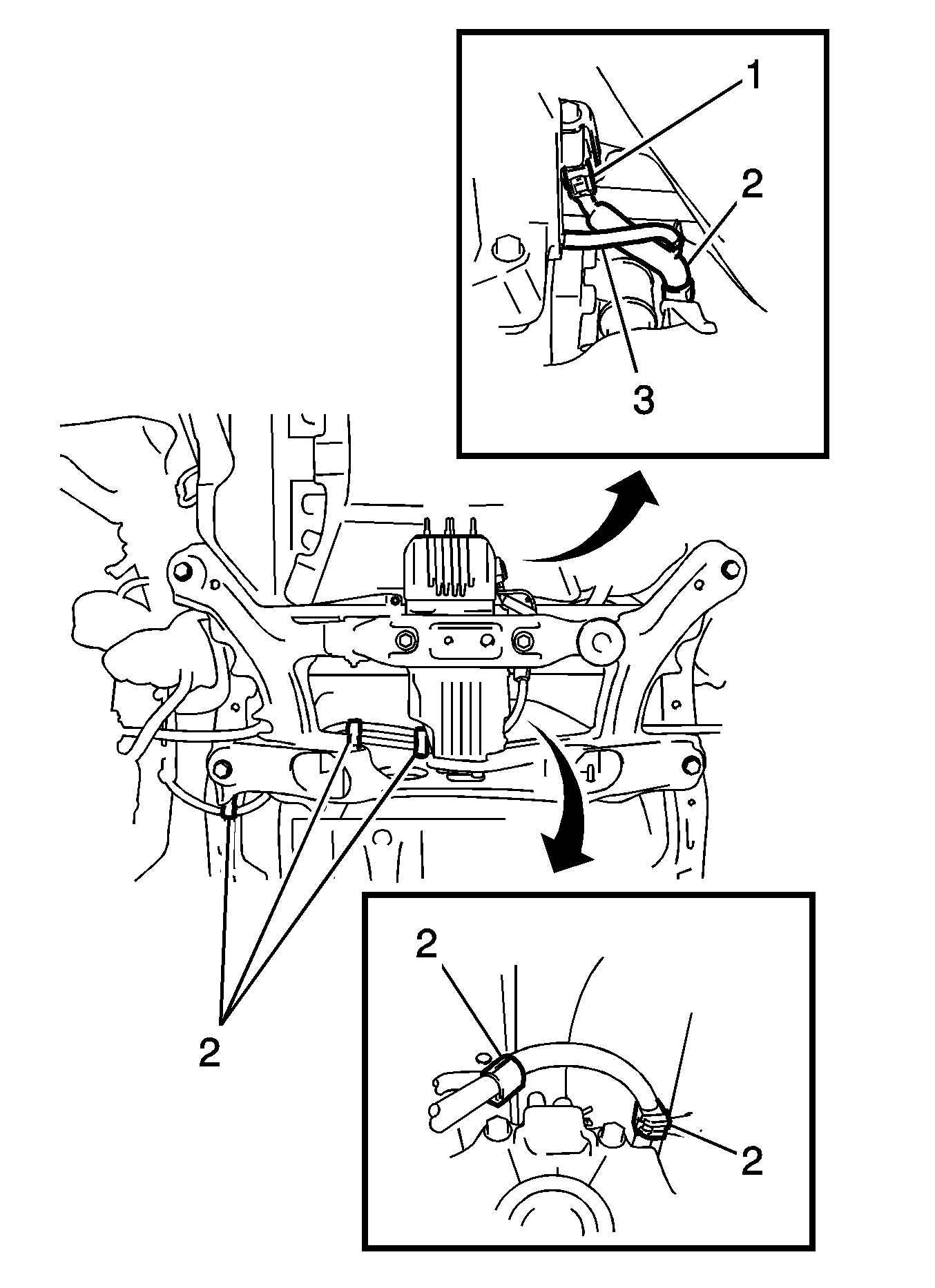
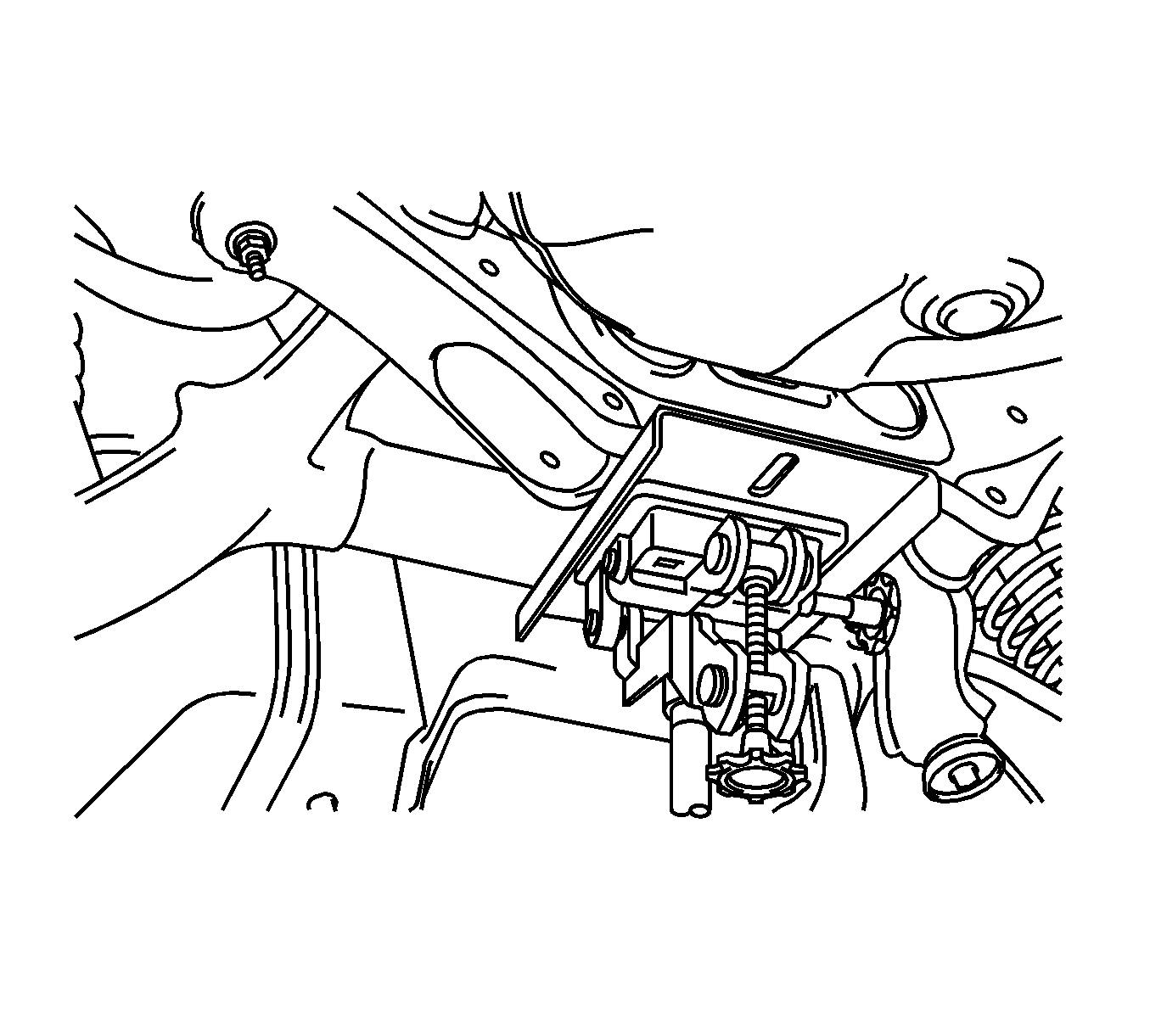
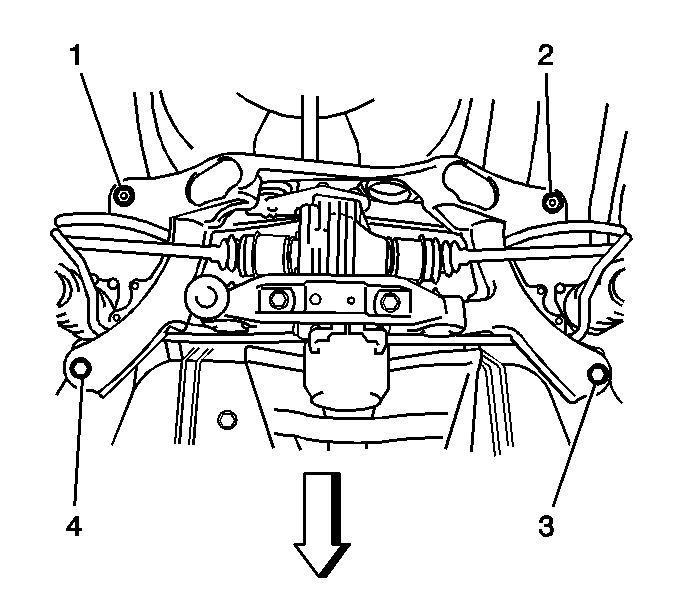
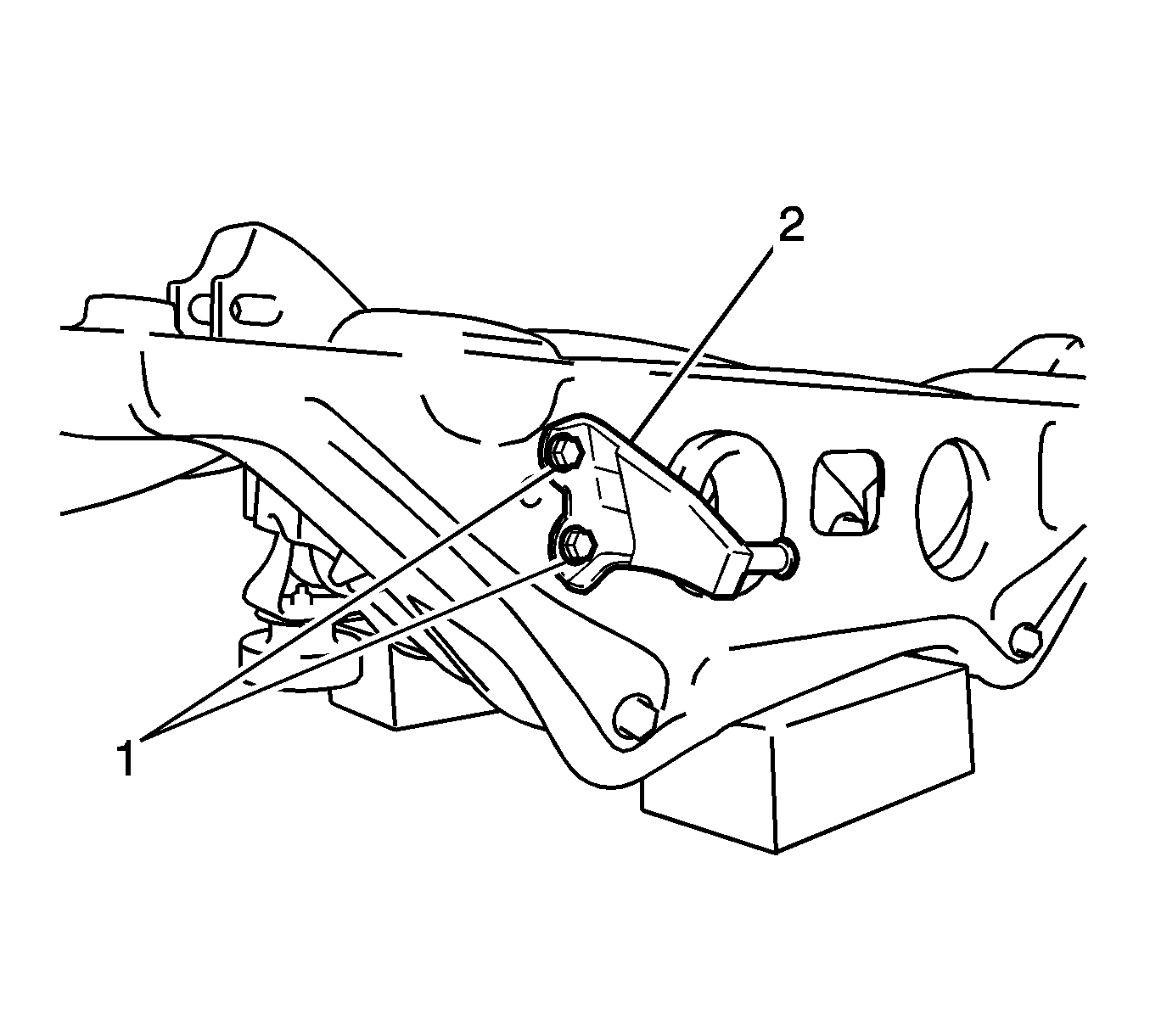
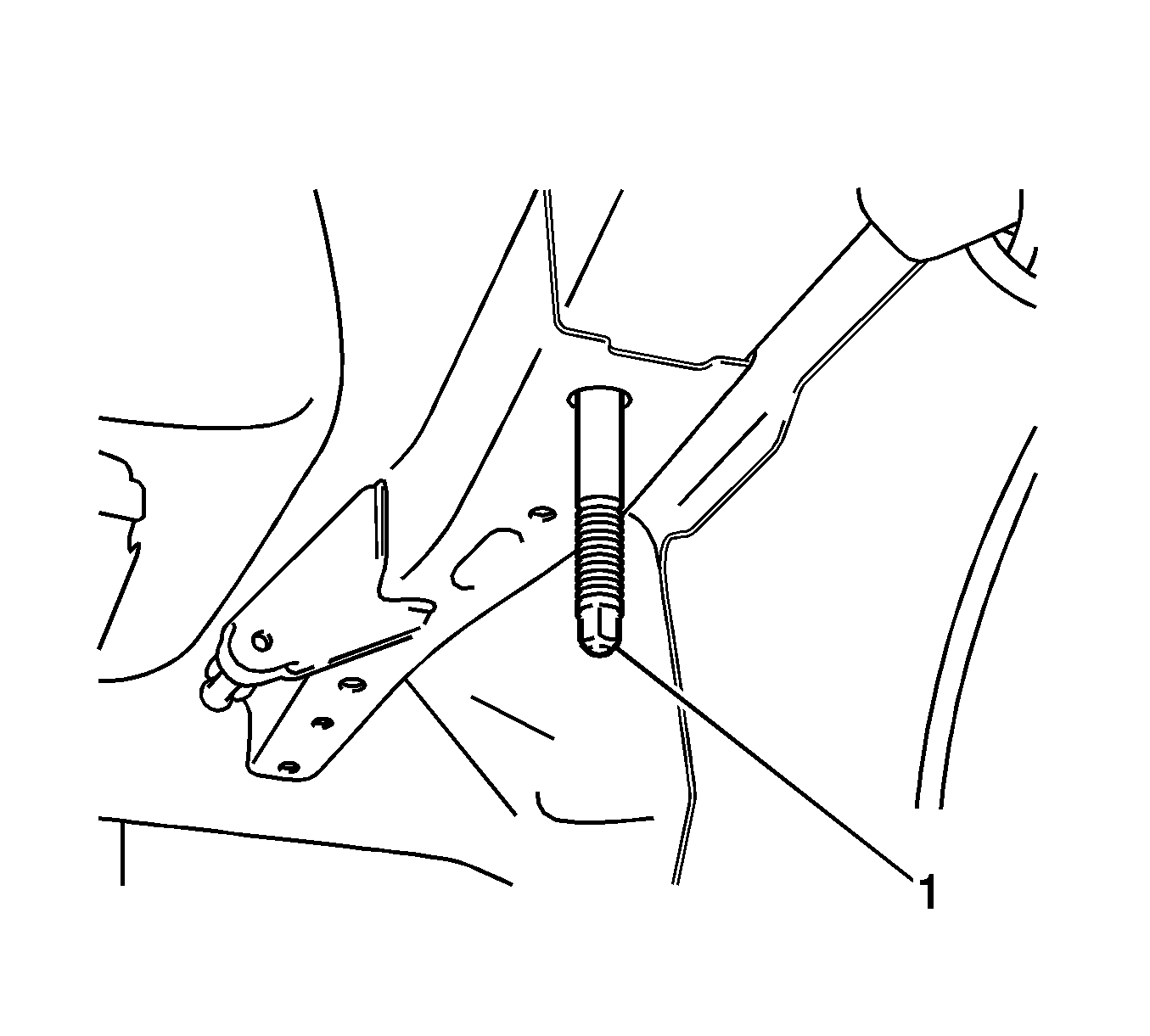
Installation Procedure
- Install the two stud bolts (1) and tighten to 17 N·m (13 lb ft).
- Install the differential carrier and the support. Refer to Differential Carrier Assembly Replacement.
- Install the exhaust bracket (2) and the two bolts (1).
- Install the stabilizer shaft. Refer to Stabilizer Shaft Replacement.
- Raise and install the rear suspension support crossmember using a jack and a block of wood.
- Install the 2 nuts (1, 2) and the 2 bolts (3, 4) in order to retain the crossmember to the body. Tighten the nuts and the bolts to 105 N·m (77.4 lb ft).
- Engage the six clamps (2) and install the wire harness and hose.
- Connect the hose (3).
- Connect the wire harness connector (1).
- Install the rear shock absorbers with the coil springs and temporarily tighten. Refer to Shock Absorber Replacement.
- Install the rear hub and bearing assembly. Refer to Rear Wheel Bearing and Hub Replacement.
- Install the rear wheel drive shafts. Refer to Rear Wheel Drive Shaft Replacement.
- If you are replacing a control arm, copy the match marks from the old components to the new components.
- Install the upper control arms, and temporarily tighten the upper control arm assembly. Refer to Upper Control Arm Replacement.
- Install the lower control arms and temporarily tighten. Refer to Lower Control Arm Replacement.
- Install the stabilizer shaft links. Refer to Stabilizer Shaft Link Replacement.
- Install the park brake assembly. Refer to Park Brake Hardware Replacement.
- Install the front park brake cable. Refer to Parking Brake Front Cable Replacement.
- Install the rear park brake cables. Refer to Parking Brake Rear Cable Replacement.
- Install the 2 rear wheel speed sensors and pigtails. Refer to Rear Wheel Speed Sensor Replacement.
- Install the rear brake rotors. Refer to Rear Brake Rotor Replacement.
- Install the rear brake calipers. Refer to Rear Brake Caliper Replacement.
- Install the rear axle shaft nuts. Refer to Rear Wheel Drive Shaft Replacement.
- Install the propeller shaft. Refer to Propeller Shaft Replacement.
- Install the catalytic converter. Refer to Catalytic Converter Replacement.
- Install the exhaust muffler. Refer to Exhaust Muffler Replacement.
- Install the 2 rear tire and wheel assemblies. Refer to Tire and Wheel Removal and Installation.
- Lower the vehicle.
- Install the negative battery cable. Refer to Battery Negative Cable Disconnection and Connection.
- Bounce the rear of the vehicle in order to stabilize the suspension.
- Fully tighten the rear upper control arms. Refer to Upper Control Arm Replacement.
- Fully tighten the rear lower control arms. Refer to Lower Control Arm Replacement.
- Fully tighten the rear shock absorbers with springs. Refer to Shock Absorber Replacement.
- Bleed the brake system. Refer to Hydraulic Brake System Bleeding.
- Measure the wheel alignment. Adjust if necessary. Refer to Wheel Alignment Measurement.
Caution: Refer to Fastener Caution in the Preface section.




Note: Do not tighten the nuts or the bolts on the suspension components. The weight of the vehicle must be on the tire and wheel assemblies before tightening the nuts and the bolts.
Rear Suspension Support Crossmember Replacement Two Wheel Drive
Removal Procedure
- Disconnect the negative battery cable. Refer to Battery Negative Cable Disconnection and Connection.
- Raise and support the vehicle. Refer to Lifting and Jacking the Vehicle.
- Remove the exhaust muffler. Refer to Exhaust Muffler Replacement.
- Remove the catalytic converter. Refer to Catalytic Converter Replacement.
- Remove the 2 rear tire and wheel assemblies. Refer to Tire and Wheel Removal and Installation.
- Remove the rear brake calipers. Refer to Rear Brake Caliper Replacement.
- Remove the rear brake rotors. Refer to Rear Brake Rotor Replacement.
- Remove the 2 rear wheel speed sensors and pigtails. Refer to Rear Wheel Speed Sensor Replacement.
- Remove the park brake assembly. Refer to Park Brake Hardware Replacement.
- Remove the front park brake cable. Refer to Parking Brake Front Cable Replacement.
- Remove the rear park brake cables from the equalizer. Refer to Parking Brake Rear Cable Replacement.
- Use containers in order to catch the brake fluid.
- Remove the rear stabilizer link assembly. Refer to Stabilizer Shaft Link Replacement.
- Remove the lower control arms. Refer to Lower Control Arm Replacement.
- Remove the upper control arms. Refer to Upper Control Arm Replacement.
- Remove the rear hub and bearing assembly. Refer to Rear Wheel Bearing and Hub Replacement.
- Remove the rear shock absorbers with the coil springs. Refer to Shock Absorber Replacement.
- Support the rear suspension support crossmember, by using a jack and a block of wood.
- Remove the evaporative emission canister. Refer to Evaporative Emission Canister Replacement or Evaporative Emission Canister Replacement.
- Remove the two bolts (1) (2).
- Remove the two nuts (3) (4).
- Lower the rear suspension support crossmember.
- Remove the stabilizer shaft. Refer to Stabilizer Shaft Replacement.
- Remove the two stud bolts (1).
Note: If you are removing the rear suspension crossmember in order to gain access to other components, you may remove the following components together as a rear drive module:
• The rear suspension crossmember • The upper control arms • The lower control arms • The stabilizer shaft • The disc brakes • The rear park brake cables

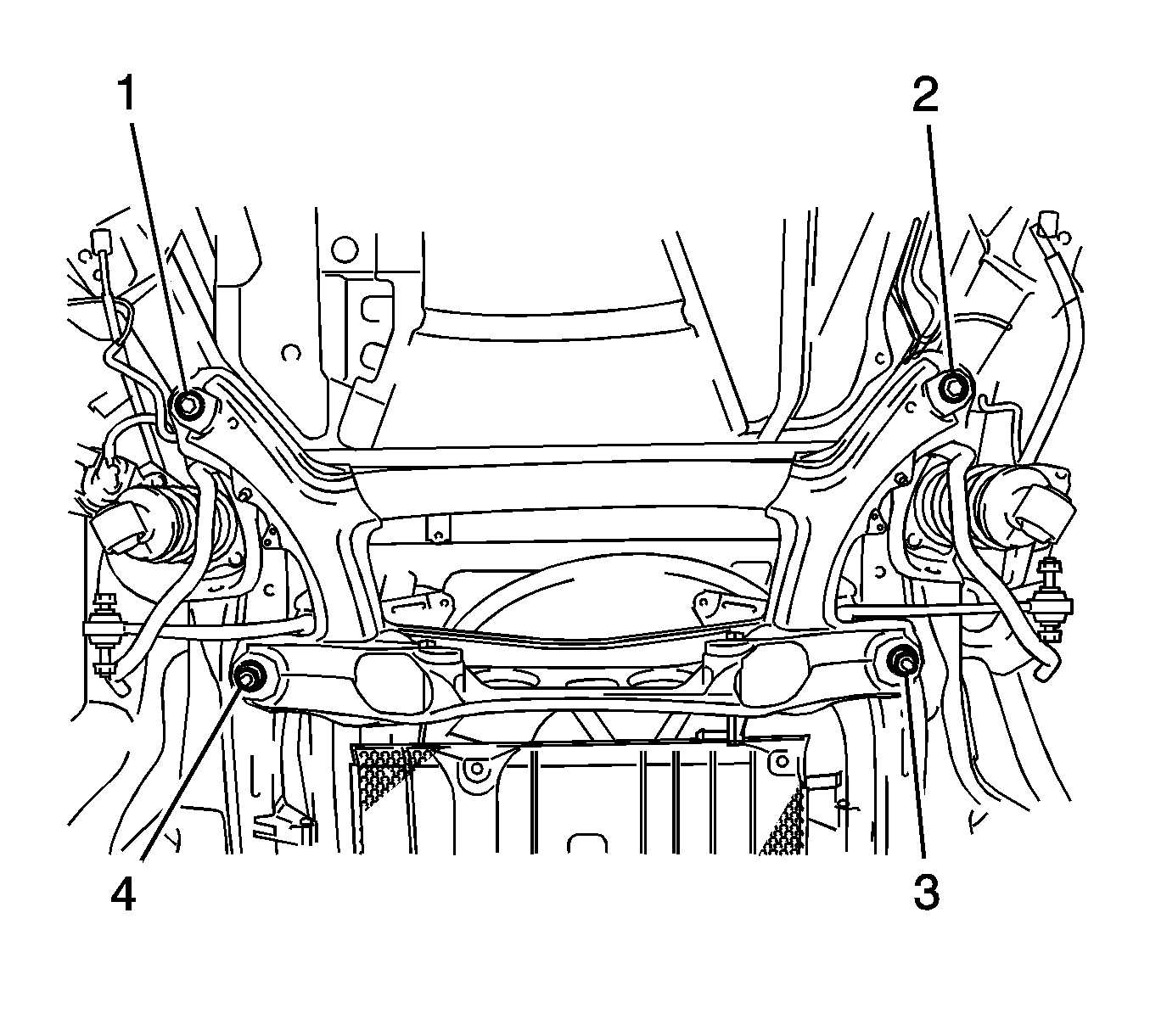

Installation Procedure
- Install the two stud bolts (1) and tighten to 17 N·m (13 lb ft).
- Install the stabilizer shaft. Refer to Stabilizer Shaft Replacement.
- Raise and install the rear suspension support crossmember using a jack and a block of wood.
- Install the 2 nuts (3, 4) and the 2 bolts (1, 2) in order to retain the crossmember to the body. Tighten the nuts and the bolts to 105 N·m (77.4 lb ft).
- Install the evaporative emission canister. Refer to Evaporative Emission Canister Replacement or Evaporative Emission Canister Replacement.
- Install the rear shock absorbers with the coil springs and temporarily tighten. Refer to Shock Absorber Replacement.
- Install the rear hub and bearing assembly. Refer to Rear Wheel Bearing and Hub Replacement.
- If you are replacing a control arm, copy the match marks from the old components to the new components.
- Install the upper control arms, and temporarily tighten. Refer to Upper Control Arm Replacement.
- Install the lower control arms, and temporarily tighten. Refer to Lower Control Arm Replacement.
- Install the stabilizer shaft link. Refer to Stabilizer Shaft Link Replacement.
- Install the park brake assembly. Refer to Park Brake Hardware Replacement.
- Install the front park brake cable. Refer to Parking Brake Front Cable Replacement.
- Install the rear park brake cables. Refer to Parking Brake Rear Cable Replacement.
- Install the 2 rear wheel speed sensors and pigtails. Refer to Rear Wheel Speed Sensor Replacement.
- Install the rear brake rotors. Refer to Rear Brake Rotor Replacement.
- Install the rear brake calipers. Refer to Rear Brake Caliper Replacement.
- Install the catalytic converter. Refer to Catalytic Converter Replacement.
- Install the exhaust muffler. Refer to Exhaust Muffler Replacement.
- Install the 2 rear tire and wheel assemblies. Refer to Tire and Wheel Removal and Installation.
- Lower the vehicle.
- Install the negative battery cable. Refer to Battery Negative Cable Disconnection and Connection.
- Bounce the rear of the vehicle in order to stabilize the suspension.
- Fully tighten the rear upper control arms. Refer to Upper Control Arm Replacement.
- Fully tighten the rear lower control arms. Refer to Lower Control Arm Replacement.
- Fully tighten the rear shock absorbers with springs. Refer to Shock Absorber Replacement.
- Bleed the brake system. Refer to Hydraulic Brake System Bleeding.
- Measure the wheel alignment. Adjust if necessary. Refer to Wheel Alignment Measurement.
Caution: Refer to Fastener Caution in the Preface section.


Note: Do not tighten the nuts or the bolts on the suspension components. The weight of the vehicle must be on the tire and wheel assemblies before tightening the nuts and the bolts.
